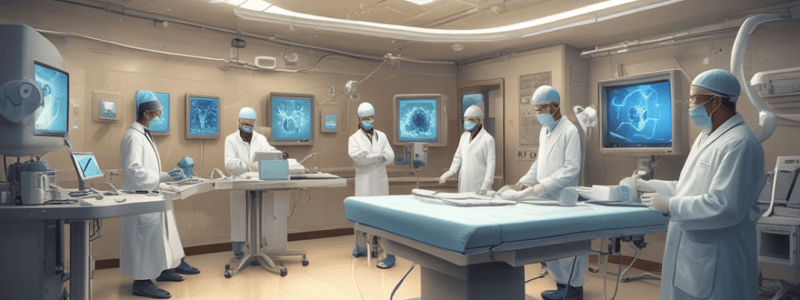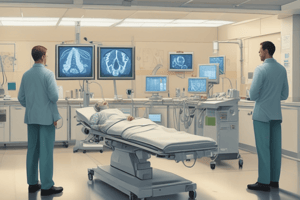Podcast
Questions and Answers
What is one of the primary advantages of using a Chest Radiograph (CXR) over a CT scan for patients with shortness of breath in an Emergency Room setting?
What is one of the primary advantages of using a Chest Radiograph (CXR) over a CT scan for patients with shortness of breath in an Emergency Room setting?
- CXR provides more detailed images of soft tissues.
- CXR uses a higher dose of radiation.
- CXR is a quicker preliminary assessment. (correct)
- CXR can identify all types of pulmonary conditions.
Which of the following is NOT a critical anatomical marker that students should identify when reading a Chest Radiograph?
Which of the following is NOT a critical anatomical marker that students should identify when reading a Chest Radiograph?
- Liver (correct)
- Trachea
- Diaphragm
- Aortic arch
In which scenario is a CT scan considered superior to a CXR?
In which scenario is a CT scan considered superior to a CXR?
- Assessing suspected pneumonia.
- Visualizing a pulmonary embolism. (correct)
- Detecting fractured ribs.
- Evaluating fluid in the pleural space.
Which organ is NOT typically identified on an abdominal X-ray?
Which organ is NOT typically identified on an abdominal X-ray?
When interpreting an abdominal CT scan with contrast, which structure should be easily identifiable?
When interpreting an abdominal CT scan with contrast, which structure should be easily identifiable?
What is a disadvantage of using Ultrasound compared to CT scan in screening for abdominal trauma?
What is a disadvantage of using Ultrasound compared to CT scan in screening for abdominal trauma?
Which method is primarily used for teaching during this Imaging session?
Which method is primarily used for teaching during this Imaging session?
What is the goal of the sessions connected to Imaging in terms of curricular objectives?
What is the goal of the sessions connected to Imaging in terms of curricular objectives?
What is primarily visualized in a chest X-ray due to its opacity characteristics?
What is primarily visualized in a chest X-ray due to its opacity characteristics?
Which anatomical structure appears more opaque on a chest X-ray due to its composition?
Which anatomical structure appears more opaque on a chest X-ray due to its composition?
What is a common use of chest radiography in an acute setting?
What is a common use of chest radiography in an acute setting?
What role does intravenous iodinated contrast play in chest computed tomography (CT)?
What role does intravenous iodinated contrast play in chest computed tomography (CT)?
Which feature distinguishes chest CT from chest X-ray regarding imaging density?
Which feature distinguishes chest CT from chest X-ray regarding imaging density?
In chest imaging, where is the carina located?
In chest imaging, where is the carina located?
Which condition is a chest X-ray most likely used to identify in an acute trauma situation?
Which condition is a chest X-ray most likely used to identify in an acute trauma situation?
When enhanced with contrast in CT, how does the appearance of intravascular structures change?
When enhanced with contrast in CT, how does the appearance of intravascular structures change?
What is the primary reason chest radiographs are the most common imaging test performed?
What is the primary reason chest radiographs are the most common imaging test performed?
Which statement accurately describes the primary function of Computed Tomography (CT)?
Which statement accurately describes the primary function of Computed Tomography (CT)?
Why is a portable X-ray machine particularly advantageous in emergency situations?
Why is a portable X-ray machine particularly advantageous in emergency situations?
In comparison to traditional radiographs, what is a disadvantage of CT imaging?
In comparison to traditional radiographs, what is a disadvantage of CT imaging?
What aspect of imaging does Computed Tomography excel in compared to conventional X-ray imaging?
What aspect of imaging does Computed Tomography excel in compared to conventional X-ray imaging?
Which of the following best describes the general process of X-ray radiography?
Which of the following best describes the general process of X-ray radiography?
What is a key limitation of CT scans compared to chest radiographs?
What is a key limitation of CT scans compared to chest radiographs?
How many chest radiographs are performed approximately every year in the US?
How many chest radiographs are performed approximately every year in the US?
What is a primary use of chest CT in an acute setting?
What is a primary use of chest CT in an acute setting?
Why is CT preferred over chest X-ray for lung cancer screening?
Why is CT preferred over chest X-ray for lung cancer screening?
What can abdominal radiographs effectively diagnose in an acute setting?
What can abdominal radiographs effectively diagnose in an acute setting?
Which anatomical structures are generally not well visualized on abdominal radiographs?
Which anatomical structures are generally not well visualized on abdominal radiographs?
What type of imaging modality is preferable for evaluating intrabdominal pathology?
What type of imaging modality is preferable for evaluating intrabdominal pathology?
In cases of small bowel obstruction, what would be noted on an abdominal radiograph?
In cases of small bowel obstruction, what would be noted on an abdominal radiograph?
What is the advantage of abdominal CT in anatomical visualization?
What is the advantage of abdominal CT in anatomical visualization?
What feature is highlighted in an abdominal radiograph indicating the presence of a NG tube?
What feature is highlighted in an abdominal radiograph indicating the presence of a NG tube?
What is a primary disadvantage of bedside chest radiographs in acutely ill patients?
What is a primary disadvantage of bedside chest radiographs in acutely ill patients?
Which condition is NOT accurately diagnosed using a bedside chest radiograph?
Which condition is NOT accurately diagnosed using a bedside chest radiograph?
What advantage does a CT scan have over bedside ultrasound in the evaluation of abdominal trauma?
What advantage does a CT scan have over bedside ultrasound in the evaluation of abdominal trauma?
In the context of pulmonary pathologies, what is a key advantage of bedside chest radiographs?
In the context of pulmonary pathologies, what is a key advantage of bedside chest radiographs?
What is a potential limitation of using ultrasound to evaluate for intra-abdominal injuries?
What is a potential limitation of using ultrasound to evaluate for intra-abdominal injuries?
What type of imaging is particularly useful for diagnosing pulmonary embolism?
What type of imaging is particularly useful for diagnosing pulmonary embolism?
In an emergency setting, what is a distinct benefit of CT scans compared to chest radiographs?
In an emergency setting, what is a distinct benefit of CT scans compared to chest radiographs?
Why is a focused ultrasound exam valuable in cases of suspected intra-abdominal organ injury after trauma?
Why is a focused ultrasound exam valuable in cases of suspected intra-abdominal organ injury after trauma?
Flashcards are hidden until you start studying
Study Notes
Instructional Methods
- Team-Based Learning (TBL) is the primary instructional method for the session.
- A flipped session format is utilized along with clinical correlation.
- Written or visual media resources are recommended for learning.
Learning Objectives
- Explain advantages of Chest Radiograph (CXR) in emergency settings over CT scan.
- Understand basics of reading a CXR and identifying critical anatomical markers.
- Identify conditions where CT scans are superior to CXR.
- Recognize major abdominal organs on abdominal X-rays.
- Identify the liver, spleen, pancreas, kidney, stomach, and colon on abdominal CT scans with contrast.
- Discuss the pros and cons of Ultrasound versus CT in assessing abdominal trauma.
Radiography and CT Overview
- Approximately 80 million chest radiographs are performed annually in the US.
- Chest X-rays are favored for their cost-effectiveness, low radiation dose, and ease of use.
- X-ray imaging relies on differences in tissue density to create images.
- CT scans provide higher spatial resolution and more detailed images than traditional radiographs but involve higher radiation exposure and cost.
Chest Radiography Anatomy
- Chest X-rays visualize thoracic structures including trachea, bronchi, lungs, heart, aorta, and ribs.
- Opacity principles: bone appears white (opaque), air appears black (lucent), and lungs appear darker due to air-filled spaces.
Uses of Chest Radiography
- In acute contexts, CXRs are used to identify rib fractures, pneumothorax, pneumonia, and pleural effusions.
- In non-emergent settings, used for preoperative evaluations and chronic cough assessments.
Chest Computed Tomography (CT) Details
- CT scans can utilize intravenous iodinated contrast for enhanced visibility of vascular conditions.
- CT images provide detailed views of the tracheobronchial tree, mediastinal lesions, and cardiovascular structures.
Uses of Chest CT
- Acute diagnoses facilitated by CT include pulmonary embolism and aortic dissection.
- Non-emergent uses include lung cancer screening; CT detects smaller lung tumors compared to CXR, aiding in early diagnosis and improved survival rates.
Abdominal Radiographs
- Key anatomical structures visible include liver, bowel loops, kidneys, and pelvic bones.
- Abdominal radiographs lack detail for soft tissue organs; other imaging modalities like Ultrasound or CT are preferred for abdominal pathologies.
Abdominal Radiograph Uses
- Useful in diagnosing pneumoperitoneum, renal stones, and bowel obstructions.
- Radiographs display lucent gas-filled structures against opaque solid organs like the liver.
Abdominal CT Advantages
- CT provides a comprehensive view of all abdominal organs and details specific injuries in trauma settings.
- Abdominal CT is more informative than X-rays or Ultrasound for assessing intra-abdominal injuries.
Bedside X-ray Evaluation
- Bedside CXRs are common in acute care for their ease and lower radiation risk.
- CXRs are effective for evaluating conditions such as pneumonia and pneumothorax but provide limited 2D information.
- CT, despite higher radiation, accurately diagnoses numerous acute diseases not well-evaluated by radiographs.
Ultrasound in Emergency Setting
- Focused Ultrasound (FAST) helps assess hemoperitoneum quickly at the bedside without radiation.
- While Ultrasound indicates the presence of fluid, CT provides greater details regarding the injury and active bleeding for treatment guidance.
Studying That Suits You
Use AI to generate personalized quizzes and flashcards to suit your learning preferences.




